Waterloo
Houses within 5km of this house
Displaying 23 houses.
Houses within 5km of Waterloo
Displaying 23 houses.
| House name | Description | |
|---|---|---|
| Longueville House | Longueville House was the seat of the Longfield family, built in 1720. Wilson, writing in 1786, refers to it as the seat of John Longfield. In the 1850s it was valued at £56 and held by Richard Longfield from the representatives of Charles P. Coote with a demesne of 312 acres. The Longfields sold Longueville to Senator William O'Callaghan in 1938. The Irish Tourist Association survey of the 1940s claims that the original lands were taken from the O'Callaghans after the 1641 rebellion and granted to Sir Nicholas Purdon. Longueville is now a country house hotel. |

|
| Lohort Castle | A 15th century tower house, restored by the Perceval family, Earls of Egmont, in the mid 18th century and inhabited by their agents. At the time of Griffith's Valuation held by the Earl in fee and valued at £27. Remodelled in 1876, the castle later became the home of Sir Timothy O'Brien, baronet, and in 1906 he was recorded as the occupier. The building was burnt in July 1921 just before the War of Independence ended when it was the residence of Sir Timothy O'Brien. It was partly restored. The Irish Tourist Authority Survey reported in 1944 that it was the residence of James McCabe who had purchased it in 1925. It is still inhabited and in 2011 it was advertised for sale. |
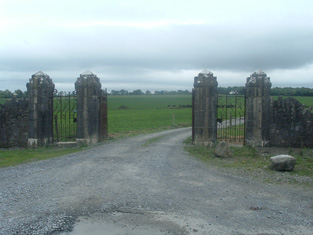
|
| Gortmore House | A late 18th century or early 19th century two storey house, the home of the Foote family in the 19th century. Occupied by Mr Thomas Clarke in 1814, by Edward Foote in 1837 and at the time of Griffith's Valuation. He held the house and demesne from Viscount Lismore. It is labelled Gortmore Castle on the 1st edition Ordnance Survey map but as Gortmore House on the later 25-inch edition of the 1890s. It is still extant. |

|
| Roskeen | The home of the Power family which was held from the Kingston estate. Pierce Power occupied the house in 1837 and John Power in the early 1850s when the buildings were valued at £24. Arthur Irwin was the occupier of this house in 1906 and it is still lived in. |
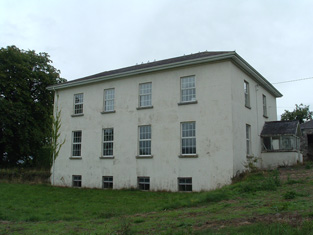
|
| Mountnorth Court | Described by Smith in the mid 18th century as a square building with two wings and fine plantations. In 1786 Wilson refers to it as "the fine and magnificent seat of Lord Lisle, with ample demesnes". This house is described as "in ruins" on the first Ordnance Survey map and modern farm buildings exist at the site now. | |
| Ballythomas | Originally a Crofts home, leased to the Bullen family by the mid 18th century. Occupied by Robert C. Bullen at the time of Griffith's Valuation. He held the house valued at £12+ and 111 acres in fee. The Crofts appear to have resumed possession in the late 19th century. Home of the O'Connors in the 20th century. |
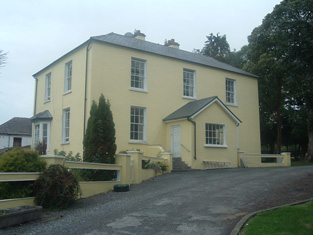
|
| Summerville | Originally a Purdon house situated on the Coote estate and described by Smith as a "neat lodge" in 1750. It was home to members of the Chapman and Nason families. Occupied by John Nicholas Wrixon in 1837. Valued at £14 in the early 1850s when it was occupied by Kenny Herbert. Still occupied and surrounded by mature woodland. |
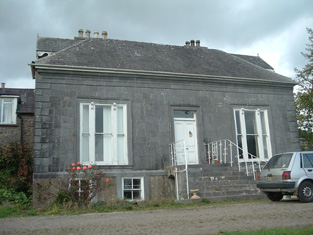
|
| Woodpark | This property belonged to the Wrixon family in the 18th century. In 1814 it was occupied by T. Callaghan. In the mid 19th century James Carmichael was in residence. He held it from the representatives of Charles D. Purcell. The buildings were valued at £11.10 shillings. Hajba writes that the Carmichaels later purchased the property from the Purcells. It is still an occupied residence. | |
| Aldworth | Hajba writes that this house was occupied by members of the Bolster family who held it from the Newmans in the late 18th century. It then became a Lombard property and passed from them to a relative, James Hunt. In the early 1850s it was occupied by James Laurence Cotter, held from James Hunt and valued at £14. This house is still occupied. Another house close by named Aldworth Lodge was also a Bolster home valued at £4+ at the time of Griffith's Valuation. A house is also extant at the latter site. |

|
| Danesfort | According to Hajba built by James Butler Stopford in the very early 19th century, replacing an earlier cottage. Stopford sold his interest to his brother-in-law, Captain Edmund Lombard a few years later. At the time of Griffith's Valuation it was occupied by the Captain's nephew, James Hunt, who held the property valued at £27.15 shillings from Christopher Crofts. In 1944 the Irish Tourist Association survey noted that it was the residence of Stopford Hunt. The house was destroyed by fire in the 1950s. | |
| Woodfort | Described in 1750 as "an handsome house, with elegant plantations" inhabited by Simeon Marshal, Surveyor General of Munster. Occupied by Ousley esq in the 1770s and 1780s, this house was the home of Richard Perry in 1814 and of T. Ware in 1837. It was valued at £30 at the time of Griffith's Valuation and still held by Thomas Weir from Charles Haynes. Later the home of the Carroll-Leahy family. In 1944 the Irish Tourist Association survey reported that it was a novitiate for the Sisters of St. Francis. This house now functions as Mount Alvernia Hospital. |

|
| Clyda | Hajba records the building of this house by Charles Haines in 1805. Occupied by Joseph Barry in 1814 and by the Reverend M. Becher in 1837. In the 1850s it was the residence of the Reverend Henry Swanzy who held it from Thomas Haynes. The buildings were valued at £24. Later the home of Lieutenant Colonel Robert D. Perry. In 1944 the Irish Tourist Association Survey noted it as the residence of Mr. Mandeville. In the late 20th century it was owed by the O'Meara family. |
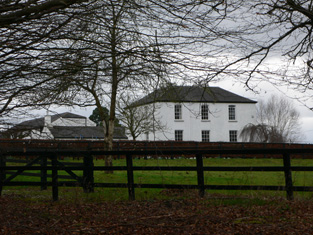
|
| Lombardstown House | The seat for many years of the Lombard family, built in the mid 18th century. In 1750 Smith refers to the house as "lately built by James Lombard". From the 1830s it was leased to the Bolster family. George Bolster held the house valued at £15 plus a demesne of 101 acres from Lady Cotter in the early 1850s. The Bolsters remained in residence until the late 19th century when they sold their interest to Henry G. Smith. His descendants continue to occupy the house (Hajba). |

|
| Fern Hill | Smith records Cornelius Townshend as resident at Betsborough circa 1750. Hajba writes that it was a Townsend property from the early 18th century and birthplace of the United Irishman, Thomas Russell, executed in 1803. The house, on the outskirts of the village of Drommahane, was originally known as Bettesborough (or Besborough) and a Magner occupied a house of this name in 1837. The Reverend Philip Townsend held the house valued at £21+ from William Magner in the early 1850s. In June 1881 the house and demesne of Fernhill were advertised for sale. Barclay Corrie was the owner, holding on a lease dated 1863 from Richard John Perry to Michael Joseph Magnier. The house was demolished in the early 20th century and a new house built on the site. |
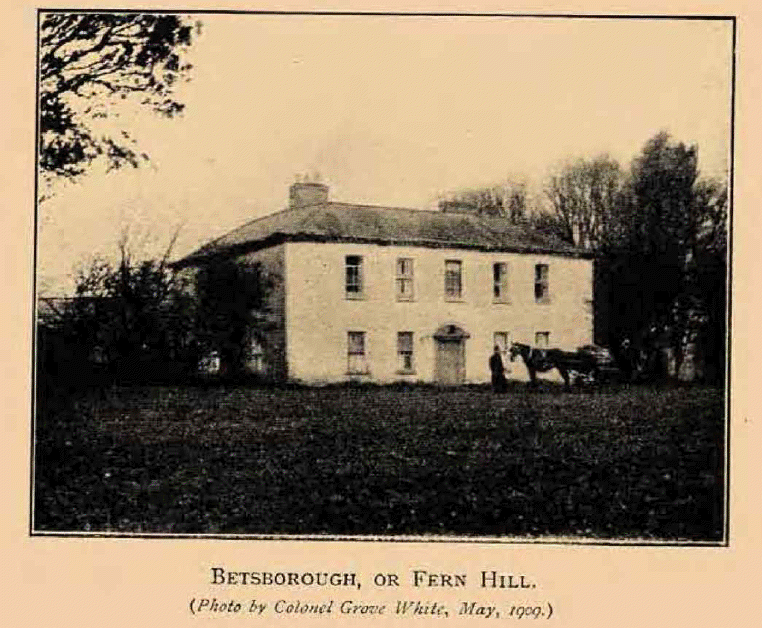
|
| Newberry House | This house was another Newman residence located in the parish of Kilshannig. In 1786 Wilson refers to Newberry as the residence of Colonel Newman, possibly the same man who was murdered in the house by his groom and an accomplice in 1816. John Newman held the property from Adam Newman at the time of Griffith's Valuation. The buildings were valued at £18.10 shillings. Post Griffith's Valuation the house became the home of the Swanzy family and it was they who built the present house incorporating the original one. The house was sold to the Footts in the 20th century. Also known as Kilshannig House. |
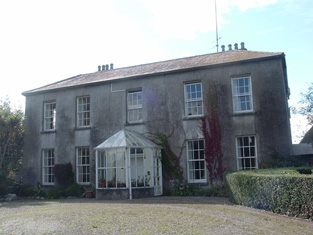
|
| Firville | A home of the Atkins family in the 18th and 19th centuries which in the early 1850s was held from John Clarke with 251 acres. Major Atkins occupied the house in 1814 and R. Atkins in 1837. Hajba writes that the Reverend Philip Atkins-Going left Firville to his unmarried daughters Charlotte and Henrietta when he died in 1861. Hussey de Burgh records Mrs Charlotte Henrietta Atkins of South Mall, Cork, owning 502 acres in the 1870s. Sold to Samuel Sheehan in 1914 this property still belonged to his descendants at the beginning of the 21st century. |
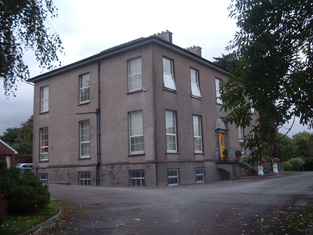
|
| Eden Hill | Situated on the Longfield estate and occupied by John Crosbie who held the house valued at £19.10 shillings from Joseph Carpenter. The Carpenter resided here from the late 18th century. Thomas Carmichael bought Carpenter's interest and advertised the sale of Eden Hill house and demesne in December 1856. Later the home of the Guerin family and in the late 20th century of the O'Callaghan family. |

|
| Ballyclogh Castle | At the time of Griffith's Valuation Thomas Haines and Son owned a house, corn and flour mill and offices in the townland of Ballyclogh valued at £82. This property was held with 4 acres from the representatives of C.P. Coote and John Wrixon. In 1906 Ballyclogh was occupied by the representatives of Charles P. Coote. The house was located adjacent to a medieval tower house. Both the house and mill are now in ruins. | |
| Blossomfort | Hajba refers to John Wrixon of Blossomfort in 1703. Wilson, writing in 1786, refers to Blossom-fort as the seat of Mr. Wrixon. The present house, occupied by William Bullen in 1814 and by J. Smith in 1837 was built by the Wrixons probably in the early 19th century. In the mid 19th century Blossomfort was the residence of Thomas Haynes who held the property from Benjamin Wrixon. It was valued at £14. Sold by the Wrixons to the Longfields of Longueville, Blossomfort became the residence of their agent, Richard Smith. This house was reconstructed following a fire in the early 1900s and is still extant. |
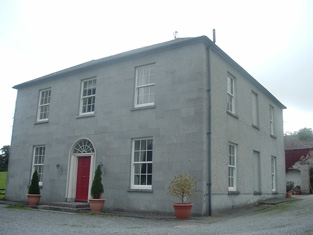
|
| Cecilstown Lodge | A home of members of the Wrixon family in the late 18th and early 19th centuries. Occupied by William Wrixon, father of Sir William Wrixon Becher, in 1837. It was leased to Thomas Heffernan from the 1840s. Valued at £9 in the early 1850s it was later occupied by members of the clergy including the Reverend E.G. Jones, whose widow bought the house in the early 20th century. It was burnt in June 1921 during the War of Independence when it was the residence of the sisters, Esther Jane and Annie Jones. A house, however, still exists at the site. | |
| Kilpatrick | Hajba writes that Roger Langley leased this property from the Longfields in the mid 18th century. Lewis writes that William J. McCormick, medical doctor,occupied the house in 1837. A boys' school was established at Kilpatrick by the McCormicks. At the time of Griffith's Valuation William J. McCormack held the house valued at almost £10.15 shillings from Christopher Langley. Sir William J. MacCormac was a well known London surgeon, the son of Dr Henry MacCormac of Belfast. The house was occupied until the early 20th century but is now a ruin. | |
| Millfort | This house was the home of the Foote family in the 18th century as Wilson refers to it as the seat of Mr. Foote in 1786. At the time of Griffith's Valuation the house was valued at £4.10 shillings, occupied by William Upplington and held from the representatives of George Foot. It appears to have fallen into ruin by the time the 25-inch Ordnance map was published in the 1890s and no trace remains now. | |
| Killetra [Mount Ruby] | Hajba writes that this house, originally known as Mount Ruby, derived its name from the Ruby family who lived there in the mid 18th century. Thomas Flynn, Justice of the Peace for Cork in 1793, married a Ruby. In 1786 Wilson refers to "Kilottery" as the seat of Mr. McCarthy. The house had a number of occupants, including John N. Wrixon, before it became the residence of Michael Jones at the time of Griffith's Valuation. It was valued at £18 and held from the representatives of Thomas Flynn. This house is still a family residence. |

